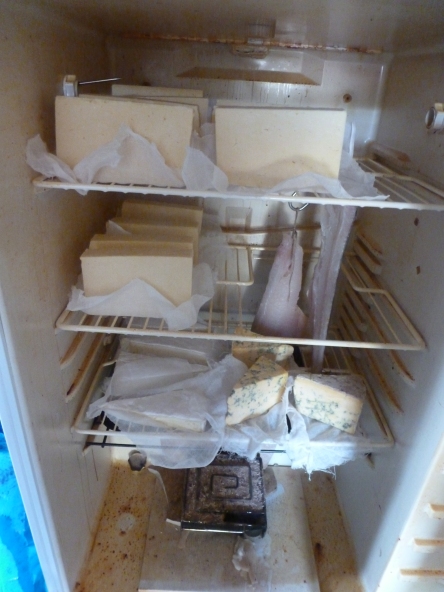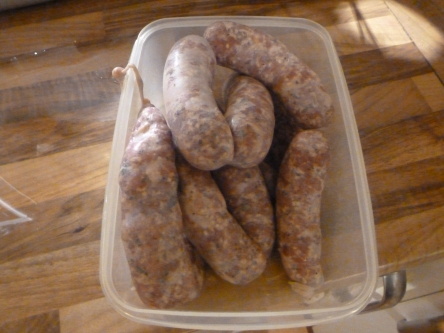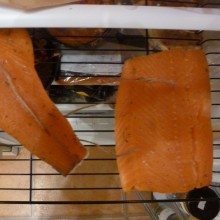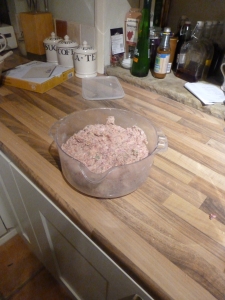You will have guessed by now that I’m getting more and more into things that take a while. Brining and smoking, sloe gin, Reubens all need more than an afternoon to do their stuff. I do want to make a pork pie soon, but first I wanted to have a go at some paté. Not your regular ‘smooth’ paté, more your pressed together chunks of pork. Again I followed Tim Haywood’s recipe, mixing:-
 500g pork shoulder
500g pork shoulder
250g back fat
250g pig’s liver
2 rashers of unsmoked back bacon
all cut into 2cm chunks. This was put in a freezer bag and marinated in:-
5g fresh parsley
2 sprigs of fresh thyme
3 ground all spice berries
75g sherry
75g white wine
black pepper to taste
To make sure everything was really mixed together it was time to get my hands into the freezer bag with all of the ingredients and scrunch them around. As much air as possible was squeezed out of the bag and then it was put in the fridge for a couple of days.
Two days later I took the bag out of the fridge, drained any excess marinade and then popped it into the food processor. I said earlier on that I wasn’t after smooth paté, but 2cm chunks are a bit too big!! A few spins of the blade reduced them a bit, still leaving it chunky.
Taking a loaf tin, first some foil was used to line the tin, and then some clink film and finally 10 rashers of streaky bacon were used to create the ‘wrapping’ for the paté. An egg and 15g of salt were added to the paté mixture and scrunched around again by hand. Once suitably scrunched this mixture was packed into the loaf tin. Firstly the bacon was wrapped over the top, then the cling film tightly wrapped around and finally the foil. Earlier I had taken a piece of cardboard the size of the loaf tin and wrapped it in foil. This was placed over the top and then I used some string to make sure that the lid stayed on and applied some pressure to the mixture during cooking.
The tin, complete with uncooked paté was placed into a pre-heated oven, 180degree. This is not quite accurate, more it was placed in a roasting tin that was then filled with boiling water that came to the lip of the loaf tin.After 2 1/2 hours the tin was taken out of the oven and weights were put onto the lid. Left on the work surface to cool for a few hours, it was then put into the fridge overnight. This allowed all of the juices and fats to set, holding everything together. It was only at this point that I unwrapped the now cooked paté from its out layers of foil and cling film.
We had some friends around a couple of days later for a bite to eat. The paté was served up with some chilli apple jelly on the side, what a great combo! Suffice to say that there wasn’t any paté left at the end of the evening!
 So, I opened my mouth or rather my email and sent out a note asking my immediate colleagues at work if they would like some smoked cheese. By the time it had been forwarded I ended up with:-
So, I opened my mouth or rather my email and sent out a note asking my immediate colleagues at work if they would like some smoked cheese. By the time it had been forwarded I ended up with:-











